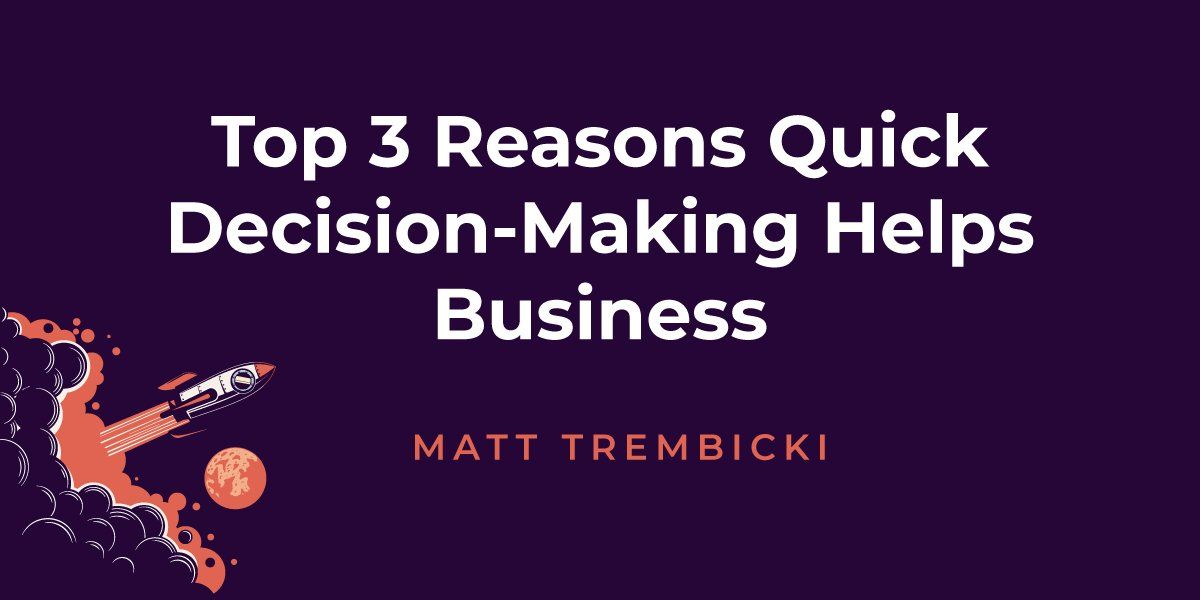Top 3 Reasons Quick Decision-Making Helps Business
Most people have been affected by less than stellar decision-making skills in their lifetime. Maybe you’ve had that boss that takes too long to make a decision, and by the time they do decide which direction to go, the deal is already dead and done.
If that’s not you, congrats because you have dodged a bullet in the business world. However, you can probably relate to another scenario: one where you have contemplated an item sitting in your online shopping cart, only to finally decide, and the item has sold out in the time it took for you to decide on your purchase.
While this type of hesitancy over day-to-day decisions is irritating, it can be more damaging in business. You could leave money on the table or not exhibit the effective leadership that maintains employee trust and engagement.
So, how do we avoid this pitfall in the professional setting? Quick decision-making
How Quick Decision Making Helps Business
The late author Robert K. Greenleaf knew the importance of quick decision-making. “On an important decision one rarely has 100% of the information needed for a good decision no matter how much one spends or how long one waits. And, if one waits too long, he has a different problem and has to start all over. This is the terrible dilemma of the hesitant decision maker.”
Greenleaf’s statement points out how slow decision-making can hinder your efforts to make a wise decision and present you with other unnecessary complications—all of which have risen (or will arise) while you were busy NOT making a choice.
So what are some of the top reasons quick decision-making helps business? Read on.
1. Boosts Revenue and Saves Time and Money
For those concerned with the bottom line, improving decision-making speed has been proven to increase revenue and save your business time and money in the long term.
Bain & Company revealed the results of a 10-year research program involving more than 1,000 companies that shows a direct link between effective decision-making and business performance. The study found that the companies that performed the highest were making— and executing—decisions quicker than their competitors. The data also revealed that those companies that struggled with decisions—deliberating versus taking action—saw their growth slow, even to the point of stagnation.
As for saving time and money, a survey by McKinsey & Company revealed that slow decisionmaking costs organizations time and money. According to the study, “Faster decisions tend to be higher quality, suggesting that speed does not undercut the merit of a given decision. Rather, good decision-making practices tend to yield decisions that are both high quality and fast.”
2. Increases Employee Engagement and Trust
The Institute for Employment Studies conducted a study revealing that the strongest driver for employees was a sense of feeling valued and involved (such as in company decision-making). This makes sense, as employee engagement increases when they are given autonomy to make decisions rather than relying on leadership to make choices for them. It also increases employees’ trust in leadership.
3. Keeps You In-Step with the Competition
No one likes to get left behind. When your company struggles with timely decision-making, it is more than likely you’ll get left in the dust of fast-acting competitors—all while your organization weighs options.
And what does your inactivity translate to? Delayed execution and subpar delivery—neither of which are going to do you or your org any favors.
How to Make Faster Decisions in Business
Now you know some of the reasons why timely decision-making is crucial, but how do you go about doing it?
Be Fast, But Don’t Be Rash
While being fast in the decision-making process is preferred, doing so at the cost of being rash is a problem. To avoid this, don’t only trust your gut, but try to find—and utilize—data supporting your decision. Having hard data also aids in recruiting others to be on board with your choices; facts help ease worries and eliminate subjective biases.
While there is no perfect way to make decisions, referring to a checklist for making faster, better decisions, like the one published by the Harvard Business Review a few years ago (yet still relevant), can help.




